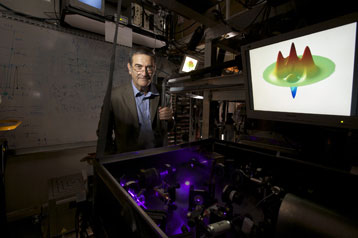| Posted: June 5, 2009 |
CNRS 2009 Gold Medal : Serge Haroche, physicist and explorer of the quantum world |
|
(Nanowerk News) The CNRS 2009 Gold Medal has been awarded to the physicist Serge Haroche. The distinction rewards a scientific personality whose work has made an exceptional contribution to the vitality and influence of French research. Haroche is a specialist in atomic physics and quantum optics. He is one of the founders of cavity quantum electrodynamics, a field which uses conceptually simple experiments to shed light on the fundamentals of quantum theory and develop prototype quantum information processing systems. Haroche, who has been a Professor at the Collège de France since 2001, leads the Electrodynamics of Simple Systems group at the Laboratoire Kastler Brossel (École normale supérieure/Université Pierre et Marie Curie/CNRS).
|
 |
| Serge Haroche
|
|
Haroche started to carry out research in 1965, at a time when atomic physics and quantum optics were undergoing a profound revolution, due to the discovery of lasers and the development of new ways of manipulating atoms with light. He played a pioneering role in the field of quantum optics research by observing atom-light interaction at the most fundamental level. In his cavity quantum electrodynamics experiments, Haroche succeeded in isolating an atom from the outside world in a cavity with nearly perfectly reflecting walls, and forced it to interact with an elementary field made up of several photons at most. The electromagnetic cavities that were used by his team at École normale supérieure (ENS) to trap light, and which enabled these experiments to be carried out, can be considered as the achievement of the 'photon boxes' that Bohr and Einstein once dreamed up in a famous thought experiment.
|
|
Haroche's work has made it possible to study and demonstrate experimentally a number of postulates of quantum mechanics that fly in the face of intuition. It has played a major role in explaining the apparently huge difference in behavior between the microscopic quantum world and the classical macroscopic world. The experiments developed by Haroche have in particular made it possible to observe the history of a single photon in an electromagnetic cavity by 'seeing' it several hundreds of times, and have shown how it disappears suddenly and unexpectedly in what is called a quantum jump. For the first time, it has been shown that it is not necessary to destroy a single photon in order to observe it.
|
|
Haroche and his team have been able to demonstrate the 'Schrödinger's cat' paradox, which refers to a thought experiment in which a macroscopic system placed in contact with a single atom is put into a superposition of two classically different states. In the ENS experiment, an atom prepared in a superposition of two energy states is coupled in a cavity to a microwave field containing several photons. Under the effect of this coupling, the field is put into a quantum superposition state, acquiring two phases at one and the same time. The researchers monitored the temporal evolution of the field, and saw how the quantum superposition state disappeared and rapidly turned into a state described by the laws of classical physics. By studying experimentally this phenomenon, known as 'decoherence', they have helped us to get a better understanding of why macroscopic systems can generally be understood using classical concepts, even though they are made up of particles that on microscopic scales obey the counterintuitive laws of quantum theory.
|
|
|
|
In addition to these very fundamental issues, the various manipulations of photons and atoms can also be used to develop prototypes that demonstrate general methods of information storage and quantum computing. In normal computers and communication circuits, information is encoded in electric or light signals as classical bits, which can take one of two mutually exclusive values, 0 or 1. On the other hand, quantum information uses 'quantum bits', or 'qubits', carried by quantum systems that can exist in a superposition of 0 and 1 states. The principle of superposition thus offers considerably enhanced computing and communication potential. Theoreticians have shown that computers making use of such qubits would be able to carry out calculations far more quickly than current computers, and would make it impossible to violate the privacy of information communication, which until now has been based on conventional cryptography protocols whose absolute reliability has not been demonstrated. The cavity quantum electrodynamics experiments carried out by Haroche and his team are making a major contribution to the development of this novel physics.
|

